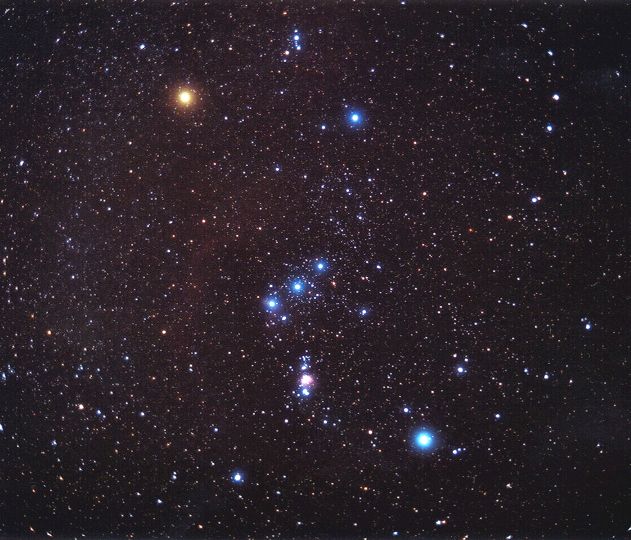 The constellation Orion, by Matthew Spinelli
The constellation Orion, by Matthew Spinelli |
The first year astronomy course consists of four 10-credit modules,
two in each semester (plus PHY116, see below).
Each module involves 20-30% assessed homework and
coursework: deadline timetables will be made available near the beginning of
each semester.
The second semester laboratory/skills module, PHY116 Professional Skills in Physics
and Astronomy II, is almost identical to PHY114 Professional Skills in
Physics II, except that you will spend three weeks in the astronomy lab doing exercises focused on astrophysics and computational skills.
PHY111 our evolving universe
- semester 1
-
- contact person
- Dr Simon Goodwin, Hicks room E49
- lectures
- Two per week, times/places to be determined
- assessment
- end-of-semester exam and class tests
| Element | Components | weight
|
| Exam | Section A, short answers | 32%
|
| | Section B, long answers | 48%
|
| Class Tests | 2, total | 20%
|
- textbook
- Nick Strobel's Astronomy Notes, or any introductory astronomy text (e.g. Ian Morison, Introduction to Astronomy and Cosmology, Bennett et al., The Cosmic Perspective).
- If you are a Dual Honours Astrophysics student, your course text Carroll and Ostlie, Introduction to Modern Astrophysics, a more advanced but well-written text, is relevant to this module and
should see you through most of your course.
- website
- course website.
PHY104 introduction to astrophysics
- semester 2
-
- contact person
- Prof. Paul Crowther, Hicks room E19
- lectures
- Two per week, times/places to be determined
- problems class
- One per week, times/places to be determined
- assessment
- end-of-semester exam, homework, class test
| Element | Components | weight
|
Exam | Section A, short questions (do all 4) | 32%
|
| | Section B, long questions (do 2 from 4) | 48%
|
| Class test | total | 10%
|
| Homework | total | 10%
|
- textbook
- The Stars:
their structure and evolution, by Roger Tayler (Cambridge
University Press, 1994)
- An
Introduction to the Sun and Stars, edited by Simon Green and Mark
Jones (Cambridge University Press/The Open University, 2003). This
book is at a noticeably lower mathematical level than the course (it
has no calculus), but is good for the more descriptive aspects.
- website
- on MOLE
PHY106 the solar system
- semester 2
-
- contact person
- Dr Katherine Inskip, Hicks room F29
- lectures
- Two per week, times/places to be determined
- assessment
- end-of-semester exam, progress test
| Element | Components | weight
|
| Exam | Do 3 questions from 5 | 80%
|
| Class test | | 20%
|
- textbook
- The New Solar
System, fourth edition, by J. Kelly Beatty, Carolyn Collins
Peterson and Andrew Chaikin (Cambridge University Press, 1999)
- An
Introduction to the Solar System, revised edition,
edited by David Rothery, Neil McBride and Iain
Gilmour (Cambridge University Press/The Open University, 2011). This
is a newer book, at a significantly lower level than The New Solar
System, but covering most aspects of the course.
- website
- module home page,
containing links to useful material.
Note that, owing to the rapid pace of solar system exploration recently (Cassini/Huygens,
Mars Phoenix Lander, Mercury Messenger, etc.), books on this topic rapidly become
out-of-date. If Dr Inskip's notes contradict the books at any point, believe the notes!
PHY115 professional skills in physics and astronomy I
- semester 1
-
- contact person
- Dr Katherine Inskip, Hicks room F29
- lectures/preparatory sessions
- two per week, weeks 1-6; one per week, weeks 8-12
- laboratory
- weeks 1-6, first year physics lab (with PHY113)
- weeks 8-11, positional astronomy lab course
- assessment
- lab work, homework
| Element | Components | weight
|
| Laboratory | Assignments | 25%
|
| | Formal report | 20%
|
| Short courses | | 20%
|
| Positional astronomy | total | 35%
|
- textbook
- For laboratory, Les Kirkup, Experimental Methods
- For positional astronomy, Fiona Vincent, Positional Astronomy (online course)
- website
- The Positional Astronomy course is on MOLE.
- Notes on Problem Solving can be found here
.
PHY116 professional skills in physics and astronomy II
- semester 2
-
- contact person
- Dr Katherine Inskip, Hicks room F29
- lectures/preparatory sessions
- one per week
- laboratory
- 7 weeks, first year physics lab (with PHY114)
- 3 weeks, astronomy lab, E36
- The three weeks spent in the astronomy lab will be chosen so as to fit the
organisation of the physics lab. This will be determined at the start of semester 2.
- assessment
- lab work, homework
| Element | Components | weight
|
| Astronomy Laboratory | Assignments | 30%
|
| Physics Laboratory | Assignments | 25%
|
| | Formal report | 25%
|
| AC Circuits | | 20%
|
- textbook
- see PHY115
- website
- none as yet
- note
- This module is essentially identical to PHY114 Professional Skills in Physics II, except for a different set of "pool" experiments/computing assignments.
|

